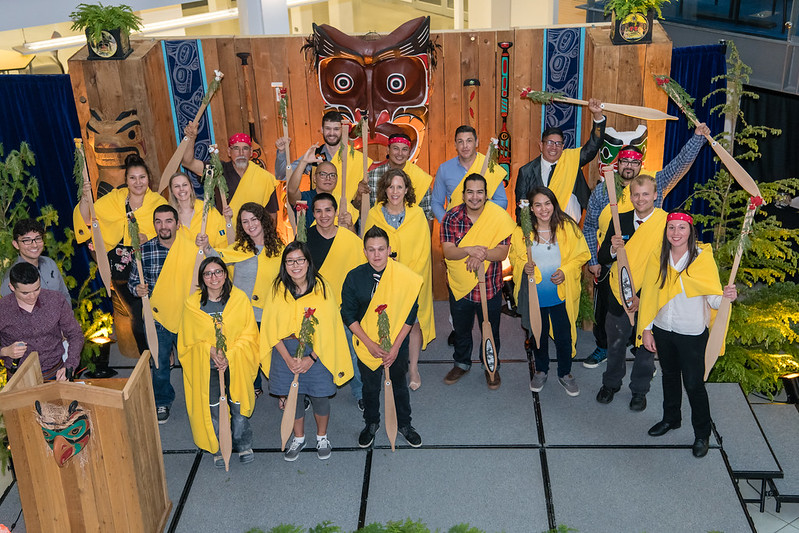Canada has done something unprecedented. Starting in 2020, corporations will have to disclose the number of women, Indigenous people, individuals with disabilities, and members of visible minorities on their senior leadership teams and boards of directors. In short, our laws are now putting into writing what many companies are already putting into practice.
It’s no secret that diversity is good for business, driving innovation and growth. That is partly why representation and inclusivity are central to the mandate at BCIT. Our programs are meant to align with the needs of companies, and companies want a workforce that truly reflect the population they serve. More than that, the Institute is committed to supporting sustainable and diverse communities. Naturally, being champions of diversity, inclusivity, and accessibility is our social responsibility.
BCIT ensures broad representation and equal opportunities are not only in the classroom, but in workplaces throughout the province and across the country. This is encoded in our strategic commitments and embedded in our programs and services.
Diversity and inclusion starts with Reconciliation

It’s important to acknowledge that BCIT is located on the traditional lands of the Sḵwx̱wú7mesh (Squamish), səl̓ilwətaɁɬ (Tsleil-Waututh), and xwməθkwəy̓əm (Musqueam) First Nations. As guests on these unceded territories, it’s both a responsibility and an opportunity to infuse Indigenous knowledge and practices in how we learn and teach, and to champion Indigenous perspectives and priorities to build greater understanding.
Our organization-wide initiatives are guided by the Calls to Action in the Truth and Reconciliation Commission, the United Nations Declaration on the Rights of Indigenous People, and the Aboriginal Post-Secondary Education and Training Policy Framework and Action Plan: 2020 Vision for the Future. By ensuring that Indigeneity is embedded and active across BCIT, we aim to create spaces where students can foster a shared sense of community on campus, celebrate their culture, and participate in traditional ceremonies—such as at BCIT Indigenous Gathering Place.
Introducing an Indigenous framework for inclusion
By embracing Indigenous learnings and teachings at BCIT, we are gifted with powerful tools to enhance inclusivity across the board. This is exemplified by Diversity Circles, a BCIT initiative that brings a distinctly Indigenous model to creating mentorship, engagement, and outreach opportunities. “The vision for this model was to eventually bring all communities, Indigenous and non-Indigenous, together for celebration and ceremony of who we are as human beings and celebrate diversity and inclusion in a meaningful way,” says Zaa Joseph, one of the co-leaders of Diversity Circles.
Experts connect to share stories in conversations, panels, and workshops, and through this interconnected approach, they’re enabling BCIT to critically rethink the student experience through lenses of intercultural diversity, neurodiversity and accessibility, and gender diversity.
Breaking barriers begin in the classroom
Several courses at BCIT are designed specifically to bring diverse talent to traditionally non-diverse industries. For instance, the School of Transportation offers a Bridge Watch Rating program that introduces women and Indigenous students to meaningful careers in the marine sector—from recreation and ecotourism to sport and commercial fisheries.
It’s all about getting underrepresented groups into the skilled trades—well-paid, rewarding professions that until recently were dominated by a small segment of society. Courses such as Trades Discovery for Women aim to increase gender diversity, giving women unique opportunities to get hands-on training in 15 different trades such as construction, manufacturing, and mechanics, as well as accreditation in HILTI, forklift training, occupational first aid, and the Workplace Hazardous Material Information System.
Have you subscribed? Sign-up to receive the latest news on BCIT.
A wide-ranging support network
Beyond the classroom, BCIT has systems in place to engage diverse students and ensure the school, in its entirety, is a safe and inclusive space. Channels such as BCIT Student Services and BCIT Accessibility Services advocate for students and empower them to succeed. Sometimes that entails specific actions, such as creating learning environments that meet individual needs or ensuring access to extra training and resources. In other cases, these services tackle more general goals such as making sure BCIT is on-track with the diversity and inclusion initiatives laid out in the strategic vision.
“Respect, diversity, and inclusion are essential to recognize, allowing employees and students from equity-seeking groups—racialized people, Indigenous people, women, people with disabilities, and members of the LGTBQ+ community—to feel that they are welcome and belong at BCIT,” says Zaa. “BCIT has continued to expand on support for all equity-seeking groups with the newly titled Respect, Diversity, and Inclusion office.”
Less formal, but no less important, is the BCIT Student Association (BCITSA), whose wide selection of student clubs actively support diversity and inclusion. BCIT Women in Computing, BCIT Women in Engineering, and BCIT Young Women in Business are just a few examples of those aimed at enhancing female participation in male-dominated industries. Other student organizations such as the Indigenous Culture Club, BCIT LGBTQ+, and Jack.Org BCIT—which raises awareness around mental health—help to bring the school, and its many communities, closer together.
Connecting the global community
At BCIT, the goal isn’t just to create a sense of solidarity within the school and among its students; rather, the scope is global. We want to grow our relevant connections abroad, and help to build collaborative relationships and sustainable communities worldwide.
The School of Construction and the Environment’s International Exchange Program enables students in Architectural Science, Civil Engineering, and Interior Design to spend a semester at one of our partner institutes overseas, while the School of Business offers Study Abroad terms and Summer Field Schools that include immersive cultural experiences.
Here at home, we also welcome the world with BCIT International Peer Mentoring, giving participants a chance to be true leaders and provide guidance to visiting students.
These initiatives are not siloed by department. They are all part of a broader culture of honouring difference at BCIT. Diversity and inclusion aren’t simply inscribed in a charter; they’re enacted every day in a variety of ways. We’re proud of the work we’ve done to change the conversation in education and in industry, ensuring that diverse communities aren’t a novelty, but a norm.
We know there is much work to be done—but we are no strangers to heavy lifting. We are committed to doing the work and leading by example. Stay connected with us to more about what BCIT is doing to move diversity and inclusion forward.
SEE MORE: At BCIT, Indigenous youth are driving Canada’s economic engine
